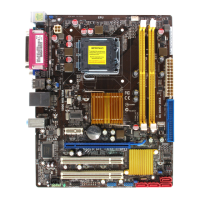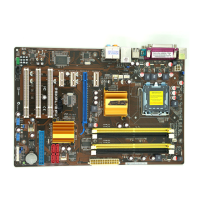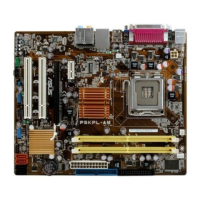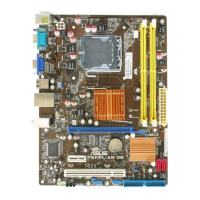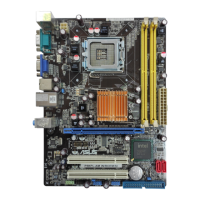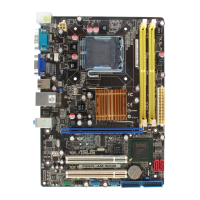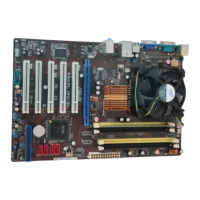Do you have a question about the Asus P5KPL EPU and is the answer not in the manual?
Lists items included in the motherboard package.
Highlights key technologies and features of the motherboard.
Safety precautions and general guidance before installation.
Visual guide to the motherboard layout and key components.
Information on installing and handling the CPU and its cooler.
Details on memory types, installation, and configurations.
Information on installing and configuring expansion cards.
Explanation of jumper settings and their functions.
Procedures for updating and managing the system BIOS.
Guide to navigating and configuring BIOS settings.
Overview of basic system information displayed in the BIOS Main menu.
Settings for advanced system configurations like CPU and chipset.
Options for managing power states and ACPI settings.
Configuration of system boot order and boot-related settings.
Access to special utilities like ASUS EZ Flash and Express Gate.
Options for saving, discarding, or loading default BIOS settings.
Compliance information regarding FCC regulations for the device.
Compliance information for Canadian radio noise emissions.
Information on compliance with REACH chemical regulations.
Precautions to prevent electrical shock hazards during handling.
Guidelines for safe operation and handling of motherboard components.
Explains the purpose and organization of the user guide.
Details on supported CPU types and features.
Information on the motherboard's Northbridge and Southbridge chipsets.
Specifications for the system bus frequency.
Details on memory architecture, type, and capacity.
List of available expansion slots like PCIe and PCI.
Information on supported storage interfaces like SATA and IDE.
Details on the integrated Gigabit LAN controller.
Specifications for the onboard high-definition audio CODEC.
Information on available USB ports and their specifications.
Features related to overclocking and system tuning.
Description of connectors on the motherboard's rear panel.
Description of internal connectors on the motherboard.
List of ASUS-specific hardware and software features.
Summary of BIOS capabilities and standards supported.
Features related to system manageability.
List of included accessories with the motherboard.
Operating systems supported by the motherboard.
Contents of the support DVD provided with the motherboard.
Physical dimensions and type of the motherboard form factor.
A welcome message to the user.
Lists items included in the motherboard package.
Details on key CPU and processor technologies supported.
Information on DDR2 memory support and performance.
Explanation of the PCI Express interface and its advantages.
Details on Serial ATA interface for storage devices.
Features of the onboard 8-channel high-definition audio system.
Connectivity for digital audio output via S/PDIF.
Information on the integrated Gigabit LAN controller.
Overview of unique features developed by ASUS.
Explanation of the ASUS Energy Processing Unit for power management.
Feature to customize the boot logo with a personal photo.
Utility for recovering corrupted BIOS files.
Utility for updating the BIOS without an OS.
ASUS exclusive OS for quick Internet and application access.
Feature to automatically restore CPU settings after overclocking failure.
Compliance with environmental standards like RoHS.
Utility for detecting and diagnosing LAN cable connection issues.
Explanation of the motherboard's standby power LED.
Guidance on orienting the motherboard during installation.
Location of screw holes for securing the motherboard.
Detailed diagram of the motherboard layout with numbered components.
List and page reference for motherboard connectors, jumpers, and slots.
Step-by-step instructions for installing the CPU into the socket.
Instructions for installing the CPU heatsink and fan assembly.
Step-by-step instructions for removing the CPU heatsink and fan.
Introduction to the motherboard's DIMM sockets and channels.
Guidance on installing DIMMs for dual-channel and single-channel modes.
List of qualified vendors and part numbers for DDR2-667 memory.
List of qualified vendors and part numbers for DDR2-800 memory.
List of qualified vendors and part numbers for DDR2-1066 memory.
Step-by-step instructions for installing memory modules.
Step-by-step instructions for removing memory modules.
Step-by-step instructions for installing an expansion card.
Steps for configuring software settings for expansion cards.
Information on types of cards supported by PCI slots.
Details on supported cards for the PCI Express x1 slot.
Details on supported graphics cards for the PCI Express x16 slot.
Procedure to clear CMOS settings using the CLRTC jumper.
Jumper for enabling keyboard/mouse wake-up feature.
Jumper for enabling USB device wake-up from sleep modes.
Description of connectors on the motherboard's rear panel.
Description of internal connectors on the motherboard.
Details on connecting CPU and chassis fans to motherboard headers.
Information on connecting ATX power supply to the motherboard.
Connectors for Serial ATA hard disk drives.
Connector for chassis intrusion detection sensor.
Connector for Ultra DMA 100/66 signal cables.
Connector for chassis-mounted functions like power, reset, LEDs.
Connectors for USB 2.0 module cables.
Connector for additional S/PDIF Out port module.
Connectors for receiving stereo audio input from sound sources.
Connector for chassis-mounted front panel audio I/O module.
Guidance on installing supported Windows OS versions.
Details on the drivers, software, and utilities on the support DVD.
Procedures for updating and managing the system BIOS.
Utility for managing, saving, and updating BIOS in Windows.
Utility for updating the BIOS without an OS.
Utility for recovering corrupted BIOS files.
Overview of the BIOS setup screen layout and navigation.
Explanation of the main menu items available in BIOS setup.
Description of keys used to navigate BIOS menus.
Explanation of how menu items are displayed and selected.
How to access and display submenu items.
How to view and change values in configuration fields.
How pop-up windows display configuration options.
How scroll bars are used to navigate long menus.
Location and purpose of the general help description.
Allows setting the system time in BIOS.
Allows setting the system date in BIOS.
Configuration for IDE and SATA devices.
Settings for configuring IDE devices and controllers.
Displays auto-detected BIOS, processor, and memory information.
Adjustments for system frequency and voltage for overclocking.
Displays and adjusts CPU frequency and FSB synchronization.
Options for selecting overclocking percentages.
Allows setting the DDR2 operating frequency.
Allows manual setting of ICH chipset voltage.
Allows manual setting of MCH chipset voltage.
Allows manual setting of FSB termination voltage.
Allows adjustment of memory over voltage settings.
Configuration options for USB-related features.
Enables or disables overall USB functions.
Enables or disables the USB 2.0 controller.
Enables or disables support for legacy USB storage devices.
Configures the USB 2.0 controller mode (HiSpeed or Full Speed).
Settings for USB mass storage device reset delay and emulation type.
Displays CPU-related information detected by the BIOS.
Sets the ratio between CPU core clock and FSB frequency.
Enables or disables C1E Support for power saving.
Allows legacy OS boot with extended CPUID functions.
Enables or disables Intel Virtualization Technology.
Enables or disables Intel CPU Thermal Monitor function.
Enables or disables the No-Execution Page Protection Technology.
Enables or disables Enhanced Intel SpeedStep Technology.
Allows changing advanced chipset settings.
Settings related to the North Bridge chipset.
Remaps overlapped PCI memory for 64-bit OS.
Enables or disables DRAM timing configuration via SPD.
Selects the primary boot device for graphics.
Settings related to the South Bridge chipset.
Allows setting the audio controller type.
Selects front panel audio support type (HD Audio or AC97).
Selects parallel port base addresses.
Selects the parallel port mode.
Enables or disables onboard devices.
Enables or disables the onboard LAN controller.
Enables or disables the boot ROM in the LAN controller.
Selects the Serial Port1 base address.
Advanced settings for PCI/PnP devices.
BIOS or OS configuration of Plug and Play devices.
Selects PCI device latency timer value.
Assigns IRQ to PCI VGA card if requested.
Enables ISA graphics device detection for PCI devices.
Assigns IRQs to PCI/PnP or reserves for ISA devices.
Selects the ACPI state for system suspend.
Adds more tables for ACPI 2.0 specifications.
Enables or disables ACPI APIC support.
Configuration for restoring system state after AC power loss.
Enables or disables Ring to generate a wake event.
Enables wake-up through PCI LAN or modem card.
Enables wake-up through PCI Express card.
Enables or disables RTC to generate a wake event.
Enables keyboard wake-up for the system.
Enables PS/2 mouse wake-up for the system.
Monitors CPU and motherboard temperatures, fan speeds, and voltages.
Displays CPU and motherboard temperatures.
Displays CPU fan speed in rotations per minute.
Enables or disables the Q-Fan control for CPU cooling.
Displays chassis fan speed in rotations per minute.
Enables or disables the Q-Fan control for chassis fans.
Displays power fan speed in rotations per minute.
Monitors onboard voltage regulator outputs.
Specifies the boot device priority sequence.
Settings for quick boot, full screen logo, and other boot options.
Skips some POST tests to speed up system boot time.
Enables or disables the full screen logo display feature.
Sets display mode for option ROM.
Selects the power-on state for the NumLock key.
Enables or disables PS/2 mouse support.
System waits for F1 key press on error.
Displays message to enter Setup during POST.
Procedure to set or change the supervisor password.
Selects access restriction level for Setup items.
Procedure to set or change the user password.
Configures when BIOS checks for user password.
Checks Realtek LAN cable status during POST.
Utility for updating the BIOS without an OS.
ASUS exclusive OS for quick Internet and application access.
Sets countdown duration before starting OS from Express Gate.
Clears Express Gate user data.
Saves selected BIOS settings and exits the setup utility.
Discards changes and exits the setup utility.
Discards selections and restores previously saved values.
Loads the default values for all BIOS parameters.
Lists items included in the motherboard package.
Highlights key technologies and features of the motherboard.
Safety precautions and general guidance before installation.
Visual guide to the motherboard layout and key components.
Information on installing and handling the CPU and its cooler.
Details on memory types, installation, and configurations.
Information on installing and configuring expansion cards.
Explanation of jumper settings and their functions.
Procedures for updating and managing the system BIOS.
Guide to navigating and configuring BIOS settings.
Overview of basic system information displayed in the BIOS Main menu.
Settings for advanced system configurations like CPU and chipset.
Options for managing power states and ACPI settings.
Configuration of system boot order and boot-related settings.
Access to special utilities like ASUS EZ Flash and Express Gate.
Options for saving, discarding, or loading default BIOS settings.
Compliance information regarding FCC regulations for the device.
Compliance information for Canadian radio noise emissions.
Information on compliance with REACH chemical regulations.
Precautions to prevent electrical shock hazards during handling.
Guidelines for safe operation and handling of motherboard components.
Explains the purpose and organization of the user guide.
Details on supported CPU types and features.
Information on the motherboard's Northbridge and Southbridge chipsets.
Specifications for the system bus frequency.
Details on memory architecture, type, and capacity.
List of available expansion slots like PCIe and PCI.
Information on supported storage interfaces like SATA and IDE.
Details on the integrated Gigabit LAN controller.
Specifications for the onboard high-definition audio CODEC.
Information on available USB ports and their specifications.
Features related to overclocking and system tuning.
Description of connectors on the motherboard's rear panel.
Description of internal connectors on the motherboard.
List of ASUS-specific hardware and software features.
Summary of BIOS capabilities and standards supported.
Features related to system manageability.
List of included accessories with the motherboard.
Operating systems supported by the motherboard.
Contents of the support DVD provided with the motherboard.
Physical dimensions and type of the motherboard form factor.
A welcome message to the user.
Lists items included in the motherboard package.
Details on key CPU and processor technologies supported.
Information on DDR2 memory support and performance.
Explanation of the PCI Express interface and its advantages.
Details on Serial ATA interface for storage devices.
Features of the onboard 8-channel high-definition audio system.
Connectivity for digital audio output via S/PDIF.
Information on the integrated Gigabit LAN controller.
Overview of unique features developed by ASUS.
Explanation of the ASUS Energy Processing Unit for power management.
Feature to customize the boot logo with a personal photo.
Utility for recovering corrupted BIOS files.
Utility for updating the BIOS without an OS.
ASUS exclusive OS for quick Internet and application access.
Feature to automatically restore CPU settings after overclocking failure.
Compliance with environmental standards like RoHS.
Utility for detecting and diagnosing LAN cable connection issues.
Explanation of the motherboard's standby power LED.
Guidance on orienting the motherboard during installation.
Location of screw holes for securing the motherboard.
Detailed diagram of the motherboard layout with numbered components.
List and page reference for motherboard connectors, jumpers, and slots.
Step-by-step instructions for installing the CPU into the socket.
Instructions for installing the CPU heatsink and fan assembly.
Step-by-step instructions for removing the CPU heatsink and fan.
Introduction to the motherboard's DIMM sockets and channels.
Guidance on installing DIMMs for dual-channel and single-channel modes.
List of qualified vendors and part numbers for DDR2-667 memory.
List of qualified vendors and part numbers for DDR2-800 memory.
List of qualified vendors and part numbers for DDR2-1066 memory.
Step-by-step instructions for installing memory modules.
Step-by-step instructions for removing memory modules.
Step-by-step instructions for installing an expansion card.
Steps for configuring software settings for expansion cards.
Information on types of cards supported by PCI slots.
Details on supported cards for the PCI Express x1 slot.
Details on supported graphics cards for the PCI Express x16 slot.
Procedure to clear CMOS settings using the CLRTC jumper.
Jumper for enabling keyboard/mouse wake-up feature.
Jumper for enabling USB device wake-up from sleep modes.
Description of connectors on the motherboard's rear panel.
Description of internal connectors on the motherboard.
Details on connecting CPU and chassis fans to motherboard headers.
Information on connecting ATX power supply to the motherboard.
Connectors for Serial ATA hard disk drives.
Connector for chassis intrusion detection sensor.
Connector for Ultra DMA 100/66 signal cables.
Connector for chassis-mounted functions like power, reset, LEDs.
Connectors for USB 2.0 module cables.
Connector for additional S/PDIF Out port module.
Connectors for receiving stereo audio input from sound sources.
Connector for chassis-mounted front panel audio I/O module.
Guidance on installing supported Windows OS versions.
Details on the drivers, software, and utilities on the support DVD.
Procedures for updating and managing the system BIOS.
Utility for managing, saving, and updating BIOS in Windows.
Utility for updating the BIOS without an OS.
Utility for recovering corrupted BIOS files.
Overview of the BIOS setup screen layout and navigation.
Explanation of the main menu items available in BIOS setup.
Description of keys used to navigate BIOS menus.
Explanation of how menu items are displayed and selected.
How to access and display submenu items.
How to view and change values in configuration fields.
How pop-up windows display configuration options.
How scroll bars are used to navigate long menus.
Location and purpose of the general help description.
Allows setting the system time in BIOS.
Allows setting the system date in BIOS.
Configuration for IDE and SATA devices.
Settings for configuring IDE devices and controllers.
Displays auto-detected BIOS, processor, and memory information.
Adjustments for system frequency and voltage for overclocking.
Displays and adjusts CPU frequency and FSB synchronization.
Options for selecting overclocking percentages.
Allows setting the DDR2 operating frequency.
Allows manual setting of ICH chipset voltage.
Allows manual setting of MCH chipset voltage.
Allows manual setting of FSB termination voltage.
Allows adjustment of memory over voltage settings.
Configuration options for USB-related features.
Enables or disables overall USB functions.
Enables or disables the USB 2.0 controller.
Enables or disables support for legacy USB storage devices.
Configures the USB 2.0 controller mode (HiSpeed or Full Speed).
Settings for USB mass storage device reset delay and emulation type.
Displays CPU-related information detected by the BIOS.
Sets the ratio between CPU core clock and FSB frequency.
Enables or disables C1E Support for power saving.
Allows legacy OS boot with extended CPUID functions.
Enables or disables Intel Virtualization Technology.
Enables or disables Intel CPU Thermal Monitor function.
Enables or disables the No-Execution Page Protection Technology.
Enables or disables Enhanced Intel SpeedStep Technology.
Allows changing advanced chipset settings.
Settings related to the North Bridge chipset.
Remaps overlapped PCI memory for 64-bit OS.
Enables or disables DRAM timing configuration via SPD.
Selects the primary boot device for graphics.
Settings related to the South Bridge chipset.
Allows setting the audio controller type.
Selects front panel audio support type (HD Audio or AC97).
Selects parallel port base addresses.
Selects the parallel port mode.
Enables or disables onboard devices.
Enables or disables the onboard LAN controller.
Enables or disables the boot ROM in the LAN controller.
Selects the Serial Port1 base address.
Advanced settings for PCI/PnP devices.
BIOS or OS configuration of Plug and Play devices.
Selects PCI device latency timer value.
Assigns IRQ to PCI VGA card if requested.
Enables ISA graphics device detection for PCI devices.
Assigns IRQs to PCI/PnP or reserves for ISA devices.
Selects the ACPI state for system suspend.
Adds more tables for ACPI 2.0 specifications.
Enables or disables ACPI APIC support.
Configuration for restoring system state after AC power loss.
Enables or disables Ring to generate a wake event.
Enables wake-up through PCI LAN or modem card.
Enables wake-up through PCI Express card.
Enables or disables RTC to generate a wake event.
Enables keyboard wake-up for the system.
Enables PS/2 mouse wake-up for the system.
Monitors CPU and motherboard temperatures, fan speeds, and voltages.
Displays CPU and motherboard temperatures.
Displays CPU fan speed in rotations per minute.
Enables or disables the Q-Fan control for CPU cooling.
Displays chassis fan speed in rotations per minute.
Enables or disables the Q-Fan control for chassis fans.
Displays power fan speed in rotations per minute.
Monitors onboard voltage regulator outputs.
Specifies the boot device priority sequence.
Settings for quick boot, full screen logo, and other boot options.
Skips some POST tests to speed up system boot time.
Enables or disables the full screen logo display feature.
Sets display mode for option ROM.
Selects the power-on state for the NumLock key.
Enables or disables PS/2 mouse support.
System waits for F1 key press on error.
Displays message to enter Setup during POST.
Procedure to set or change the supervisor password.
Selects access restriction level for Setup items.
Procedure to set or change the user password.
Configures when BIOS checks for user password.
Checks Realtek LAN cable status during POST.
Utility for updating the BIOS without an OS.
ASUS exclusive OS for quick Internet and application access.
Sets countdown duration before starting OS from Express Gate.
Clears Express Gate user data.
Saves selected BIOS settings and exits the setup utility.
Discards changes and exits the setup utility.
Discards selections and restores previously saved values.
Loads the default values for all BIOS parameters.
| Form Factor | ATX |
|---|---|
| Chipset | Intel G31 |
| CPU Socket | LGA 775 |
| Memory Slots | 2 x DIMM |
| Memory Type | DDR2 |
| Maximum Memory | 4 GB |
| PCIe x16 Slots | 1 |
| PCIe x1 Slots | 1 |
| PCI Slots | 2 |
| SATA Ports | 4 x SATA 3Gb/s |
| Audio Chipset | Realtek ALC662 |
| Audio Channels | 6-Channel |
| Max. LAN Speed | 10/100/1000 Mbps |
| Supported CPU | Intel Core 2 Quad / Core 2 Duo / Pentium Dual-Core / Celeron |
| FSB | 1333/1066/800 MHz |
| IDE | 1 x ATA100 |
| USB Ports | 8 x USB 2.0 |
| LAN Chipset | Realtek 8111C |
| PS/2 Ports | 2 |
| Audio Ports | 3 x Audio Jacks |
| Power Connector | 24-pin ATX, 4-pin ATX 12V |
